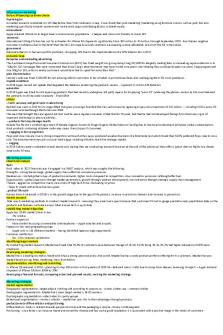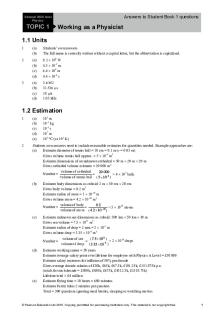Answers: LEVEL: AS BUSINESS STUDIES – Marketing PDF

| Title | Answers: LEVEL: AS BUSINESS STUDIES – Marketing |
|---|---|
| Author | Robert Cloud |
| Pages | 4 |
| File Size | 25 KB |
| File Type | |
| Total Downloads | 17 |
| Total Views | 91 |
Summary
Answers: LEVEL: AS BUSINESS STUDIES – Marketing 3. Brand names and marketing strategies (25 minutes) Cold drinks have taken over from tea as the UK’s favourite drink. In 1996 it is estimated that consumers drank 8 billion litres of tea but over 10 billion litres of soft drinks. This trend is set to ...
Description
Answers: LEVEL: AS
BUSINESS STUDIES – Marketing
3. Brand names and marketing strategies (25 minutes) Cold drinks have taken over from tea as the UK’s favourite drink. In 1996 it is estimated that consumers drank 8 billion litres of tea but over 10 billion litres of soft drinks. This trend is set to continue as Coca-Cola believes that the UK is still an immature market with consumers drinking on average only 150 cans of fizzy drink per year compared with the 300 cans per year in the US. The UK cola market is worth a staggering £6 billion. It is dominated by Coke and Pepsi, although recently has faced competition from supermarket own brands and Virgin Cola (see table). UK Market Share Coke/Pepsi Own Label Virgin Cola Other Brands
% 78 14 4 4
The impact of Virgin Cola In October 1994 Virgin launched its cola drink with an exclusive deal with Tesco and were able to capture 6% of supermarket sales. Cola sales in supermarkets account for 56% of the total market, the rest being sold through small retailers and vending machines. Virgin opted for the Tesco deal so as to minimize marketing costs and keep distribution simple with large deliveries to central locations. Virgin Cola was helped enormously by using the Virgin brand name and by the ‘free’ publicity the so-called ‘cola war’ generated. Branson ensured plenty of media coverage with his claim that Coke and Pepsi were charging a higher price or ‘Brand Tax’ to pay for their expensive and exhaustive advertising campaigns. The response of Coke and Pepsi Coke responded not by matching Virgin’s price cuts but with a £40 million advertising campaign that stressed its product as the ‘real thing’. Coke was not overly concerned because it believed that the UK market still had plenty of potential for growth and that Virgin could not challenge Coke’s supremacy in the small retail sector. In this area Coke and Pepsi between them control over 94% of the market. They believe that the much higher cost of establishing a national distribution and service network is beyond Virgin’s capability. On the larger market Pepsi has launched a world-wide advertising campaign. The £500 million ‘Project Blue’ aims to differentiate Pepsi from its main rival Coke and other brands such as Virgin Cola by changing the colour of the Pepsi can to electric blue. Coke meanwhile has used its considerably larger financial resources to invest heavily in the emerging markets. Investment in the early 1990s in Eastern Europe alone amounted to over £1.5 billion.
Copyright © Pearson Education Limited 2001
1
Answers: LEVEL: AS
BUSINESS STUDIES – Marketing
(a) With reference to the article, explain the following terms. (i) Brand names. (2 marks)
Brand names are a means of distinguishing a product from its rivals through a name that is heavily promoted. In the article, Coca-Cola, Pepsi and Virgin are all examples of brand names. Successful branding adds value to a product and creates brand loyalty. (ii) Immature market. (2 marks)
An immature market is one in which there is still scope for expansion for both existing producers and new entrants. In this case Coca-Cola believes there is potential for growth in the UK as consumers drink only half as much fizzy soft drinks as those in the America. (iii) Own brand. (2 marks)
An own brand or own label is a product bearing the retailer’s name made by a manufacturer to the retailer’s specifications and sold at a price level below that of the brand leader. In the soft drinks market Sainsbury’s Classic Cola is an example of a cheaper own brand. (b) Calculate the annual value of cola sales for: (i) Coca-Cola/Pepsi. (1 mark)
Annual value of Coca Cola/Pepsi = 78% of £6 billion = £4.68 billion (i) Virgin Cola. (1 mark)
Annual value of Virgin Cola = 4% of £6 billion = £0.24 billion
Copyright © Pearson Education Limited 2001
2
Answers: LEVEL: AS
BUSINESS STUDIES – Marketing
(c) Considering the various marketing strategies available, explain why: (i) Virgin might choose a strategy that concentrates on price and place. (8 marks)
Strategy involves both short-term and long-term objectives. Many students neglect to assess what the next stage will be and how this relates to the limited view given in the case study. Your reply should cover the following points: Coke and Pepsi are well established brands backed by enormous promotional budgets. The way for Virgin to compete is on price and, to a limited extent, on place. With a lower price Virgin is trying to tempt low-budget consumers to buy its product. Virgin is cleverly using the idea of avoiding a ‘brand tax’ to persuade consumers to buy a similar quality cola at a lower price. Virgin’s ‘place’ strategy is based on selling through a major supermarket, Tesco, in order to limit the cost of distribution. Virgin realises that it cannot compete with Coca-Cola’s and Pepsi’s widespread network without spending a great deal of money. This is not yet possible on their smaller profit margins. In the long run Virgin will only be a threat if it begins to compete in the small store and vending machine sectors of the market. This will only be a possibility if market share grows and profits improve. (ii) Coke and Pepsi might stress promotion. (5 marks)
Coke and Pepsi are a duopoly as they control over three-quarters of the fizzy drinks market. They already possess well established market leading brands and they are keen to protect their own market share. Competition between the two is fierce. Any loss of market share by one will greatly enhance the profits of the other. They stress promotion, therefore, as a means of maintaining brand loyalty, expanding existing consumer consumption and capturing new customers. They avoid price competition as this will reduce profit margins without significantly increasing overall sales. They each have a sophisticated and widespread distribution network so place in the UK is not a factor. 1 mark for each valid point, to a maximum of 5 marks.
Copyright © Pearson Education Limited 2001
3
Answers: LEVEL: AS
BUSINESS STUDIES – Marketing
(d) Why may Coke and Pepsi feel threatened by own-label products and the emergence of Virgin Cola. (4 marks)
o
UK Market is still growing.
o
Consumption is only 150 cans per consumer compared with 300 cans in America.
o
Own brands and Virgin only compete in the supermarket segment.
o
The cost of setting up a wide distribution network is too expensive for its rivals.
o
Large promotion budgets ensure high market share.
o
As the market expands they will enjoy further economies of scale, enabling Coke and Pepsi to increase promotion further or to engage in some limited price reductions.
Up to a maximum of 4.
(Total marks 25)
Copyright © Pearson Education Limited 2001
4...
Similar Free PDFs

Business case studies marketing
- 2 Pages

3 - Business level strategy
- 3 Pages

Business Level strategy
- 14 Pages

Marketing 1000 Case Studies
- 11 Pages

Business level strategy Samsung
- 5 Pages

Business studies st6 syl
- 29 Pages
Popular Institutions
- Tinajero National High School - Annex
- Politeknik Caltex Riau
- Yokohama City University
- SGT University
- University of Al-Qadisiyah
- Divine Word College of Vigan
- Techniek College Rotterdam
- Universidade de Santiago
- Universiti Teknologi MARA Cawangan Johor Kampus Pasir Gudang
- Poltekkes Kemenkes Yogyakarta
- Baguio City National High School
- Colegio san marcos
- preparatoria uno
- Centro de Bachillerato Tecnológico Industrial y de Servicios No. 107
- Dalian Maritime University
- Quang Trung Secondary School
- Colegio Tecnológico en Informática
- Corporación Regional de Educación Superior
- Grupo CEDVA
- Dar Al Uloom University
- Centro de Estudios Preuniversitarios de la Universidad Nacional de Ingeniería
- 上智大学
- Aakash International School, Nuna Majara
- San Felipe Neri Catholic School
- Kang Chiao International School - New Taipei City
- Misamis Occidental National High School
- Institución Educativa Escuela Normal Juan Ladrilleros
- Kolehiyo ng Pantukan
- Batanes State College
- Instituto Continental
- Sekolah Menengah Kejuruan Kesehatan Kaltara (Tarakan)
- Colegio de La Inmaculada Concepcion - Cebu









